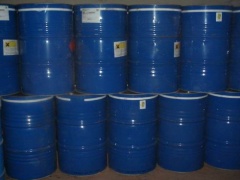Difference between revisions of "Dioctyl Phatalate.jpg"
| Line 1: | Line 1: | ||
{{Infobox_Miscellaneous | {{Infobox_Miscellaneous | ||
| image = Dioctyl_Phthalate.jpg | | image = Dioctyl_Phthalate.jpg | ||
| − | | origin = | + | | origin = - |
| − | | stowage factor = | + | | stowage factor = - |
| − | | humidity and moisture = | + | | humidity and moisture = - |
| − | | ventilation = | + | | ventilation = - |
| − | | risk factors = | + | | risk factors = See text |
}} | }} | ||
| + | ==Description== | ||
| + | Diocthyl Phthalate or Bis(2-ethylhexyl) phthalate (di-2-ethylhexyl phthalate, DEHP; dioctyl phthalate, DOP), is an organic compound with the formula C6H4(C8H17COO)2. This compound is the most common of the class of phthalate plasticizers. It is the diester of phthalic acid and the branched-chain 2-ethylhexanol. This colourless viscous liquid is soluble in oil, but not in water.<br><br> | ||
| + | DEHP has a low vapour pressure, but the temperatures for processing PVC articles are often high, leading to release of elevated levels, raising concerns about health risks. It can be absorbed from food and water. Higher levels have been found in milk and [[cheese]]. It can also leach into a liquid that comes in [[contact]] with the plastic; it extracts faster into nonpolar solvents (e.g. oils and fats in foods packed in PVC). Food and Drug Administration (FDA) therefore permits use of DEHP-containing packaging only for foods that primarily contain water. In soil, DEHP contamination moves very slowly because of its low solubility in water. Therefore, leaching from disposed plastics in landfills is generally slow. The US EPA limits for DEHP in drinking water is 6 ppb. The U.S. agency OSHA's limit for occupational exposure is 5 mg/m<sup>3</sup> of air. | ||
Revision as of 10:34, 15 April 2013
| Infobox on Dioctyl Phatalate.jpg | |
|---|---|
| Example of Dioctyl Phatalate.jpg |  |
| Facts | |
| Origin | - |
| Stowage factor (in m3/t) | - |
| Humidity / moisture | - |
| Ventilation | - |
| Risk factors | See text |
Dioctyl Phatalate.jpg
Contents
Description
Diocthyl Phthalate or Bis(2-ethylhexyl) phthalate (di-2-ethylhexyl phthalate, DEHP; dioctyl phthalate, DOP), is an organic compound with the formula C6H4(C8H17COO)2. This compound is the most common of the class of phthalate plasticizers. It is the diester of phthalic acid and the branched-chain 2-ethylhexanol. This colourless viscous liquid is soluble in oil, but not in water.
DEHP has a low vapour pressure, but the temperatures for processing PVC articles are often high, leading to release of elevated levels, raising concerns about health risks. It can be absorbed from food and water. Higher levels have been found in milk and cheese. It can also leach into a liquid that comes in contact with the plastic; it extracts faster into nonpolar solvents (e.g. oils and fats in foods packed in PVC). Food and Drug Administration (FDA) therefore permits use of DEHP-containing packaging only for foods that primarily contain water. In soil, DEHP contamination moves very slowly because of its low solubility in water. Therefore, leaching from disposed plastics in landfills is generally slow. The US EPA limits for DEHP in drinking water is 6 ppb. The U.S. agency OSHA's limit for occupational exposure is 5 mg/m3 of air.











